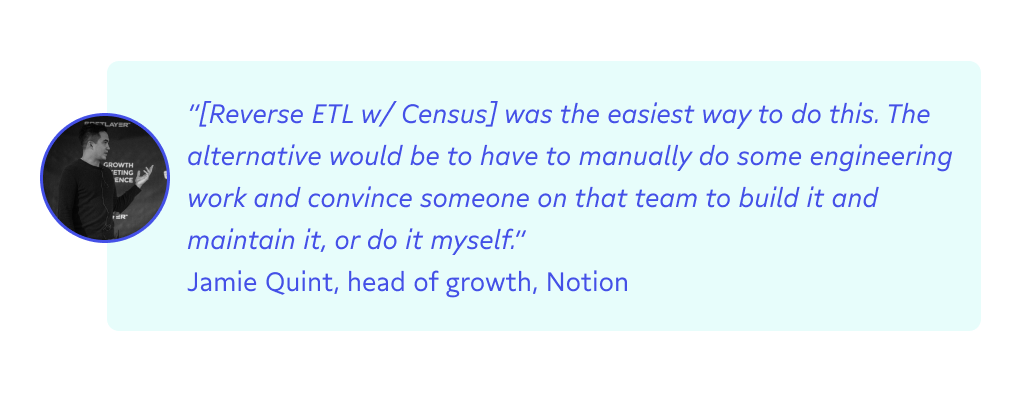This article is part of our good to great series highlighting some of the amazing things cutting-edge companies have done with reverse ETL to operationalize their data. We've also featured data and sales team stories. 😍
Marketers: Do you worry about how you can squeeze out more traffic and leads from your current strategy (and show ROI for your efforts)? If you’re like 47% of folks in your discipline, probably.
Customers’ expectations around experience get higher every year, while increased regulation around tracking and customer data privacy makes it harder and harder to meet that demand. We know you want to be a good steward of your user data while also getting the most out of the data you’re collecting.
Thankfully, SaaS tools can help you, if you have the correct data tools to support them.
We’ve seen companies that struggle to engage and connect with customers transform their marketing efforts to build meaningful relationships with users. We've watched as reverse ETL has unlocked new functionality within existing marketing tools like Braze to take campaigns and experiments to new heights. And we’ve celebrated alongside industry leaders as their marketing teams not only become more effective at converting customers but making them happy as well.
Trust us, you can do it, too. But if you need some hype, we got you. Here’s the story of how two companies—Notion and Canva—went from good to great with reverse ETL.
Notion: Realizing the romance of reverse ETL
When all-in-one digital workspace management tool Notion first heard of reverse ETL, they weren’t sure it was for them.
The company was early in its data journey and had focused on getting data into its warehouse. So they didn’t quite see why they should do more work to pull all that data out of the warehouse right after putting it there.
However, a few months later, Jamie Quint, head of growth at Notion, started to see the light. He wanted to get data from Snowflake into Salesforce, Facebook Ads, and Customer.io so his team could put together a 360-degree customer view, granular segmentation, and ad retargeting more effectively.
But, at the time, Jamie was one of 13 people on the team, and they had to optimize for value and time wherever possible. Which meant he knew he didn’t have time to build reverse ETL himself.
It was a no-brainer.

Now, thanks to reverse ETL, Notion can easily share segments across tools and integrate them into Salesforce workflows to power lead scoring and better understand their product-qualified leads (PQLs). Beyond Salesforce, they can sync data into Facebook custom audiences with ease.
“Now we don’t have to go through a whole time-consuming process of ex-porting email addresses, and reuploading them on a regular basis in order to update them. That just wouldn’t have been very feasible for us. So having an automated tool to do that was pretty important.” - Jamie Quint, head of growth, Notion
The TL;DR? It’s hard to say it better than Jamie has: “Do you have the problem of getting data into other tools? If so, you should definitely use [reverse ETL]. It's great.”
✅ No need for custom integration requests.
✅ Quickly and easily get data into Salesforce workflows for lead scoring and PQLs.
✅ No more manually reuploading email addresses for custom audiences.
Want to learn more? Check out Notion’s full customer story here.
Canva: Another chapter in an epic story of user segmentation
If you read our success stories for data teams, you're already a little familiar with Canva and their reverse ETL use case. If you didn't give it a quick read, it's worth checking out.
If you just want to get the marketing-team plotline though, no judgment. Here’s a reminder on their stack and use case: Canva started using reverse ETL to get data from Snowflake into Braze, Salesforce, Facebook Ads, and Google Ads for segmentation, email personalization, and retargeting efforts.
As we touched on in the data teams story, Canva struggled to get the data their marketing team needed into Braze, which made it hard for them to send relevant and targeted messaging to their 55+ million users.
They knew data maturity wasn’t where it needed to be, and the marketing team wasn’t seeing ROI on Braze. Thankfully, with reverse ETL, they could get the data into Braze to fuel more complex segments and reach users with targeted messaging.
From there, the marketing team created detailed campaigns for all their customers, including breakouts for hardcore Presentation users to get the information each person needed in front of them to drive conversion and build loyalty. With this shiny-new reverse ETL functionality and upgraded Braze usability, the marketing team was also able to run experiments around ad targeting with different propensity scores for each user, testing business impacts more quickly than ever.
✅ Better ROI from existing tools.
✅ More actionable user data to drive segmentation and personalization.
✅ Faster experimentation with ad targeting and user propensity scoring.
Want to learn more? Check out Canva’s full customer story here.
What’s next? Take control of your own data story with reverse ETL
We hope you’ve enjoyed learning about how great people can make a real difference to their entire organization’s operations, vision, and customers with reverse ETL. It's not just that reverse ETL lets marketing teams do more with data than ever before (that's pretty neat though). Reverse ETL lets you operationalize your data, maximize your time, drive more business value, and focus on the work that lights you and your team up.
Thinking about checking out reverse ETL tools to see what you can achieve? We have just the thing for you: our Ultimate guide to evaluating reverse ETL vendors. Grab a copy, check it out, and share it with all the great people on your team.

















